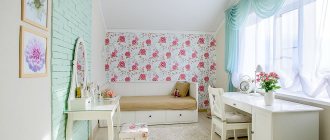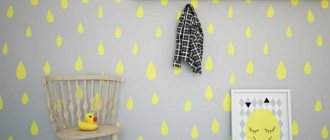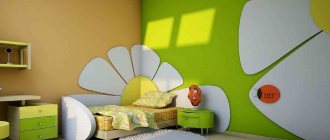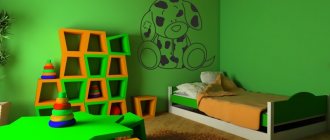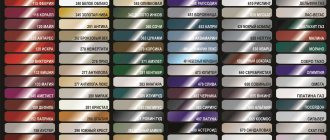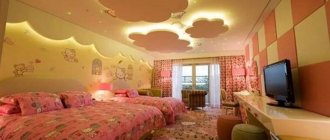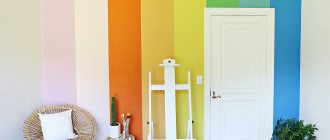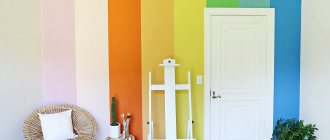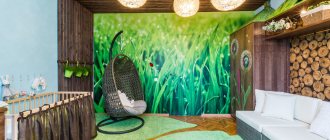assets/from_origin/upload/resize_cache/iblock/6d8/600_450_2/6d840fcb291811e01f4d3b21d1391c63.jpg From this article you will learn:
- Can the color of a children's room affect the mood and even the health of a child?
- What color of a children's room should parents of temperamental children prefer?
- Is it possible to decorate a children's room entirely in one color?
- Is it necessary to dilute the white color in the interior of a children's room with bright accents?
- What color can you decorate a room for a girl and a boy?
All mothers and fathers want their children to grow up in good conditions. Arranging a child's room is one of the most important processes for parents of a baby. When preparing the room, you should pay attention to many nuances that will affect the mood, physical health and psychological development of the child. In this article we will answer the question of what color to choose for a children's room to create a comfortable and cozy environment.
Where to start choosing the color of a children's room
They usually try to design a nursery using bright colors; they also install unusual upholstered furniture. This raises important questions: what shade of wallpaper should I choose for the children’s room or what color should I paint the walls of the nursery? There is no definite answer to these questions, since the final solution will be based on many factors.
When choosing a color scheme, you need to keep in mind:
- Gender of the baby.
- Child's age.
- Taste preferences.
- Individual characteristics of the baby.
Take the test
In addition, it is worth paying attention to the specifics of the children's room itself. There are times when the shades you like are not suitable for a certain room due to several reasons:
- nursery location;
- lighting level in the room;
- dimensions of the children's room;
- furniture that has already been selected.
Features of wall design
Some nuances should be taken into account:
- For a baby's room, it is advisable to use a more neutral decor so as not to cause visual irritation to the child.
- The materials used for wall decoration must be hypoallergenic, environmentally friendly and safe for health.
- You should choose higher quality and durable wall coverings with the easiest possible maintenance.
- In order to diversify the interior and prevent it from becoming boring, you can combine several finishing options at once.
What color is the children's room and how does it affect mood and health?
- White
Universal white is great as an answer to the question of what color of a children's room is best for a child. A bright room has a beneficial effect on people's mood and perfectly reflects sunlight and artificial light. However, a large amount of this color subconsciously evokes a feeling of restraint. A white ceiling in a room is quite acceptable, but walls painted white, combined with light-colored furniture, can curb a child’s enthusiasm and inspiration. For a child's room, it is better to opt for a milky, cream or beige color.
In its unchanged form, a room that is too light and monochromatic is not suitable for boys and girls. If you decide to make walls in these shades, add bright details in the form of furniture and other decorative elements.
- Red
Red helps increase brain activity, stimulates brain activity, improves mood. But do not forget that your child will also rest in this room, so try not to overdo it with these shades. Red curtains or other textiles can interfere with your baby's healthy sleep. From this we can conclude that it is better to use red as accents in the interior. For example, a bright red glass vase or a lampshade on a table lamp will look good.
- Orange
This color is not as aggressive as red, although they are somewhat similar. It sparks creativity and, in some cases, even boosts self-esteem. Orange shades can improve mood and increase appetite. However, despite all the advantages, you should not overload the nursery with this color. You can, for example, focus on one wall and paint it orange. But this technique should be used only if the baby’s gaze is not directed at a bright wall while resting.
- Yellow
Yellow color has many different shades - from bright to calm tones. Basically, this color helps to awaken activity and improve attention.
Recommended articles on this topic:
- Children's room design
- Bedroom interior
- How to make an apartment cozy
In a room with yellow flowers, a person is not threatened with depressive, sad states. In addition, an interesting fact is known: grades in exams held in rooms with yellow walls are usually higher. This color encourages you to gain new knowledge and helps you concentrate.
- Green
This color is common in living nature and promotes relaxation. Perhaps in such an environment a person intuitively feels himself in a natural safe environment. All shades of green have a positive effect on overly active children, but if the baby is already slow and calm, then a room of this color can worsen the situation. Balance can only be achieved with the right combination of green and other colors.
- Blue
The color blue is not as simple as it might seem. On the one hand, it helps you relax and unwind. On the other hand, it interferes with concentration and does not allow you to concentrate. This situation is very correctly described by the phrase “flying in the clouds.” Blue should be placed in the relaxation area and avoided near the desk.
- Blue
This color behaves quite capriciously in rooms. One of the positive aspects is that it has a beneficial effect on sleep and relieves fatigue well. However, it is no coincidence that the English word translated as blue is a homonym for blues. A large amount of blue color has a bad effect on attention and makes you feel sad.
- Violet
The color purple is a controversial topic among psychologists. Some consider it the color of creative people, while others think that this color is close to fantasy and makes you forget about reality. But in any case, shades of purple (as well as red) are best used as accents. And it is advisable to use a light color rather than a rich and deep one.
- Grey
Many people associate this color with boredom and monotony. But it is worth noting that, like all other colors, gray has its advantages. It has a calming effect and instills confidence. It is not for nothing that it is used so often to make business suits. To make the nursery look interesting, add bright colors, because gray goes well with other colors.
- Black
This color is not recommended for decorating the walls of a children's room. Sometimes teenagers deliberately add black elements to the interior. This is not a reason for special worries, but if this happens, you should pay attention to all changes in the child’s actions. Perhaps at the moment the son or daughter really needs parental understanding and support.
One way or another, teenage boys will love a room decorated in black and white.
Knowing the baby’s hobbies and character, parents will be able to make the right choice and determine which wall color for the children’s room is best suited to create harmony. Thanks to color balance, sleep and academic performance will improve. Of course, you shouldn’t paint a child’s room one shade and hope that all problems will be solved. For the correct timely development of personality, it is necessary to remember other, equally important factors.
For boy
Not only functionality and favorite colors should be present in the design of the room. It is very important that the interior also serves as a reflection of the teenager’s unique personality. Even if your preferences change every week (and this is exactly what happens in adolescence!), you can settle on something that will appeal to everyone over the next few years until the next renovation.
Psychologists believe that a correctly selected color palette helps in the development of personality: the potential of color therapy can hardly be overestimated, since everyone has colors that calm and others that irritate. You just need to identify them!
A young man’s room should have only all the essentials: a rationally organized workplace (perhaps not only a table, but also a small workbench or a place for working on technical issues), a bed, a wardrobe and a combination of a bookcase with shelves for all the most beautiful and necessary.
If your child loves Gothic and demands black walls and dark furniture, do not despair and invite him to read materials that explain in reasonable language that the color black has a depressing effect on the psyche, and a person may begin to develop depression.
But do not forget that a teenager is a maximalist who can stubbornly defend his point of view.
You will need to stock up on images of stylish designs in advance, in which only one wall or one corner of the room is given the opportunity to actively demonstrate the taste preferences of the occupant of the room. Other corners should be decorated in a different color.
If you and your child have a good, trusting relationship, it will not be difficult for you to explain to him that neutral wall colors make it possible to extremely diversify other decorative elements. The main thing is to decide on the theme and style!
Boy's room styles and colors
The main styles of modern decor that can be used when decorating a room for a teenager.
- Avant-garde, high-tech - the style of cool techies and computer scientists. Predominant primary colors: gray, steel, black, white, auxiliary colors (1 or 2) - lemon, red, mustard, sky.
- Country is a “rustic” style for household and household items. Predominant primary colors: brown, red, white, sand, secondary colors – green, beige, yellow.
- Safari, marine, genre. Any combination of colors is possible, but, as in other options, there should be no more than three primary colors.
- Kitsch and loft are the favorite styles of talented artists, musicians, and future architects. With this decision, it is customary to decorate with glossy surfaces and bright colors: scarlet, sea green, yellow, green, blue.
Temperament and color in a boy's room
As a rule, by adolescence, a child’s basic inclinations and needs have already been identified, and it is better to follow the recommendations of psychologists. They claim that choleric people prefer red and all its shades, sanguine people cannot do without glimpses of yellow and gold, melancholic people prefer blue, and phlegmatic people prefer green.
This is the “internal” palette of temperaments, while in practical life melancholic people most often choose warm tones, such as brown, orange or yellow, choleric people and sanguine people choose the coolness of blue, green, white, and so on with each type of temperament.
You need to make color blanks and decide what a teenager will enjoy looking at for a long time, and what will cause negativity.
You shouldn’t try to “re-educate” your temperament type to suit someone else’s preferences. Each of them is good in their own way, each has shortcomings, you can (and should!) live with all this, and live as comfortably as possible, and then everything will be fine!
Let the teenager draw room design options in a point or cockatiel, and you can adjust them together.
Color schemes for a teenage boy's room: photos
High-tech minimalism can be expressed in light gray walls. White can be used as the main color for furniture. For example, it could be a white bed frame with a dark gray mattress and colorful pillows, with black and white poster graphics above the bed.
Let there be a white cabinet, and to rest your eyes, place another one nearby - sand color or beige.
You shouldn’t be afraid of this color; the main thing is to select furniture with easy-to-clean surfaces. A white desk with multiple compartments for the computer, homework, and tech skills can take up an entire wall. A black and white striped carpet will complement the overall scheme and add a touch of mischief to the interior.
- A room in the “country” style consists of a cozy (possibly made in patchwork technique) blanket and carpet next to the bed, wooden furniture, preferably in natural colors, built-in wardrobes and shelves, comfortably decorated niches and window spaces.
- A sea or safari theme includes a wall-sized geographical map, an image of an active volcano, a “cave” bed and many other possibilities for imagination. Porthole windows, lifebuoys on the walls, flags and rope ladders - all this will allow the interior to look complete.
Anyone who likes to make technical models can easily decorate a room with them, and not only with them.
There may be photo curtains with airplanes on the windows, an exhibition of car models on the shelves, and photographs depicting any equipment that is of interest on the walls. The general background of the walls can be deep blue, sea green or beige, the furniture can be dark or light wood, depending on the wishes of the teenager. Lamps can be of original design. Alternatively, you can make the lampshades yourself.
What color combination to choose for a children's room: rules for a harmonious interior
Do not forget that the interior will be more interesting if you combine colors in decoration and furnishings in an original way. Thus, it is possible to allocate separate zones for various types of children’s activities: a place to sleep, play and study. Each requires a correctly selected color arrangement. Zoning the nursery will help instill in the child the habit of order.
Children perceive colors very sensitively, so choosing a palette for your baby’s room should be approached responsibly. Next, we will tell you how to find the right solution and what color scheme to prefer so that children are as comfortable as possible.
Rule 1: Combine bright colors with neutrals.
With age, a child's preferences usually change: children 5–9 years old often like bright colors, such as red, crimson, orange, while teenagers tend to choose more subdued colors - beige, yellow and green. Therefore, the best solution would be to use bright colors as accents on some interior details, while leaving the walls neutral. This will help balance the area of the room and in the future, easily replace these decorative elements with others.
Rule 2: Choose light over dark.
When arranging a nursery, do not use dark color transitions, since shades that gradually turn into black have a negative impact on the child’s psyche. Light colors, on the contrary, will immediately fill the room with a pleasant, joyful atmosphere, which will have a beneficial effect on the development of children. An excellent solution would be to use ivory shades with the addition of golden specks and paint the walls with sky blue paint.
Rule 3. Pay attention to the location of the windows.
The position of the nursery is of great importance. The amount of sunlight is extremely important for the mental development and physical health of babies: constant exposure to a dark and cold room can lead to fatigue, drowsiness and discomfort.
Therefore, if the room’s windows are located on the north or west side, choose light, warm shades and add bright colors. A children's room located in the south or east requires the use of cold tones; they will look quite interesting. Also a good solution would be to combine warm and cold delicate shades, for example, light gray and yellowish.
Rule 4. Use good combinations
A good idea would be to use a two-tone design for a children's room. A combination of light green and sandy shades with a slight addition of specks of opposite tones will add a certain originality and beauty to the room. A gray palette with orange details or a light lilac shade will look quite elegant. And the usual combination of light green and pink will help enliven the space and fill it with special energy. Look for the right combinations!
Rule 5. Allow children to choose for themselves.
The children's room must be liked by the child himself. Be sure to find out your child's opinion about the design of the room - most likely, you will get new ideas. Don’t forget to offer your own options - this way you will take into account the children’s preferences and not make a mistake in choosing shades.
It makes no sense to ask your child what color to paint the children's room. Better ask: “Do you like this yellow or this green better?”
Rule 6. Take ideas from the Scandinavian style.
Scandinavian style details are often used in the interior of children's rooms - it is laconic and involves the use of eco-friendly materials and a light range of shades. However, some designers are interested in the question: are Scandinavian cool tones suitable for a children's room?
Currently, the Scandinavian new style is in demand, where the main shade is not traditional white, but completely different tones. They certainly remain calm, but also add an interesting character to the room, which is very suitable for a nursery. For example, it could be pale green, peach, gray, salmon and other unusual shades.
How to choose shades?
As the main background, it is better to use a light and neutral palette (pale, with a blue tint or aquamarine). Bright and rich colors (dark turquoise, pearl) will be needed to decorate one of the walls (accent) or as decorative elements.
Light turquoise children's wallpaper will help visually increase the space. And richer and deeper colors will refresh sunny rooms.
Don't be afraid to improvise and give up monochrome! A turquoise nursery will only benefit from having an accent wall! Feel free to use stripes and prints (within the same spectrum or contrasting solutions).
This way the child’s room will acquire taste and personality.
The choice of colors largely depends on the child’s temperament.
Mischievous and restless children need restrained shades with a green undertone (for example, light green or sea green). And for quiet people, more intense, cheerful options paired with bright details are suitable.
Textiles can contrast with the main background or be within the same spectrum. If you don’t want to take risks, then opt for white weightless curtains. Plain or patterned - it doesn’t matter, the main thing is not to overload the situation.
But if neutral-colored walls and bright details are necessary, then feel free to hang turquoise curtains in the nursery.
It is better to use wooden texture as a floor covering. This will add comfort and harmony. Don't forget about carpets. The color scheme can contain all the shades used in the interior or be monophonic.
What color is suitable for a girl's nursery?
The palette of shades in a girl’s room can be varied, depending on the taste preferences of the little one and the originality of the parents. Thematic designs are often used; motifs from fairy tales and cartoons are quite in demand among parents. If your daughter supports this idea, then pink shades in the children's room will be the main ones for this design.
This solution is considered optimal because:
- many girls love pink tones;
- it will be a good combination with other shades;
- does not have a negative impact on the mental development of the child;
- visually enlarges a small room;
- makes the room brighter if there is not enough sunlight.
If the selected wallpaper is of this shade, then you can also apply a floral pattern. This decor can be used on wallpaper and other details in the interior of a children's room. Any girl will definitely like this design, especially since you can decorate the room using different elements.
Wall design for a teenager's room
Photo wallpaper, graffiti, intricate illustrations or an accent brick wall will make the design of the room memorable and bright and emphasize the individuality of the room. Most often, the interior is decorated in modern styles, which allow a teenager to develop a sense of taste and self-sufficiency.
The main thing is that the decor is fashionable and stylish, and opens up free opportunities for self-expression.
The photo shows a teenage girl's bedroom with a white brick wall.
What color is best for a boy's nursery?
Boys usually like more contrasting color combinations. Among the decorations for boys' rooms, all shades of blue, as well as the full range of green, have become very popular.
A nursery in green tones can be made not only for a boy, but also for a girl. By making this decision, you can cope with several important tasks at once. As is already known, green helps to calm down and feel harmony. This will be extremely useful for boys, as they are usually active by nature.
A light green shade can be a good alternative to green. It has the same positive beneficial qualities.
If you want to decorate a nursery in blue tones, it is better to give preference to its shades, for example blue. It is well suited for children who are not too active; its main feature is that it increases performance. It would be great if a school student’s room was decorated in this color scheme.
Both of these colors go well together, therefore, using one of them, parents automatically use the other to additionally decorate the room. The sleeping area or play area can be decorated with green details, and the work space should be done in blue tones. In such a nursery, it is necessary to place indoor flowers - they will complement the overall idea.
Psychological meaning of color in the interior
Every person encounters color every day. In addition, most people have a favorite shade. Professionals in psychology have long proven that they are able to influence our mood and activity. A treatment called color therapy is used.
It is not surprising that color also has an impact on a child’s development and psyche. A child growing up in dark, black colors is unlikely to want to actively do something or learn new things. Also, the shade can “adjust” the character.
The influence of different shades on a child and an adult is different
The red tint of paint is an irritant. It causes activity. Therefore, you need to be very careful with it. But you can use it in detail to focus the child’s attention.
Yellow refers to bringing harmony and concentration. It is perfect for excited, nervous children. Also, do not forget that yellow is a shade of sun and joy.
Green is a shade of life and confidence. It encourages knowledge.
Green has a fairly strong influence on child development
Blue is the shade of imagination. Interior details in shades of blue are able to concentrate a child's attention.
The blue tone can calm the baby after an active day. However, an excess of blue can lead to depression and apathy.
Orange is a bright, cheerful color. It will help the child to be more sociable.
It is worth noting that shades are important. The same color, but in different shades, can evoke different and sometimes opposite emotions.
Universal options for those who don’t know what nursery color to choose
White and green shades for the walls in the nursery are a standard solution for both boys and girls. Cool or warm tones of other colors also work great. Children's rooms are often decorated in light colors, especially if the room is intended for very young children. In the future, the interior can be supplemented with decorative elements and bright details, such as photographs, fabric appliqués, baby’s drawings or paintings.
White is considered universal in many situations:
- visually increases the size of the room;
- makes the space brighter;
- combines well with other shades;
- suitable for children of all ages;
- has a beneficial effect on the child's psyche.
This list is suitable for many families. As mentioned earlier, white in the interior of a nursery must be complemented with colorful details both in furniture and in additional elements. This will help make the atmosphere in the room more cheerful.
Speaking of green, it can be noted that it is not inferior to any other design ideas. You can also choose walls for the nursery such as peach, cream, champagne and other similar shades.
For heterosexuals
To zone a room for two children of different sexes, it is best to use two primary colors in the interior. We are talking about pink and blue shades. This is a great option if the kids are small. After all, kids love everything bright.
Also, the design can be unusual, using various themes: jungle, fairy-tale characters, cartoons, animals, etc.
If this is a room for teenagers, then you can choose other colors. For example, wallpaper in purple-gray, pink-green, yellow-blue shades will look good. You can also use wallpaper in peach and apricot tones to decorate the walls. The color of sea green looks good in interior design, especially in combination with gray or khaki.
In addition, wallpaper of the right color can visually enlarge a small space. In this case, it is better to give preference to light colors in the design: beige, pastel, vanilla.
Remember that zoning a room with color is not just about choosing wallpaper. This is also a choice of furniture, carpets, textiles, and accessories.
How to decorate parts of the wall in the nursery?
Wall accents can balance and complete a room.
- Above the bed. This design technique allows you to add versatility and interest to the interior. The decorated space above the bed, in tune with the general style direction, will add individuality to the decor.
- Accent wall. It can be decorated using photo wallpaper, bright colors, wallpaper with variegated and large patterns, or other materials with a voluminous texture. This accent will become the main visual focus and will concentrate the main attention on itself.
The photo shows an accent wall with plant patterns in the bedroom of a teenage girl.
Thanks to the play of contrasts, you can create the main eye-catching visual point in the room.
Pompoms, stickers, appliques
To make the interior unique, you can paint the walls in the children's room. You can resort to the services of an artist, but it’s better to do it together with your child - it’s troublesome, but very exciting. The easiest way to decorate is to paint the walls evenly in one tone. You can add personality with paintings, stickers and other accessories.
Vinyl stickers are great as an accent. They stick easily and are also easy to peel off and move to another location. You can also assemble applications from geometric stickers.
For girls, you can make an accent with pompoms. Multi-colored soft lumps can be placed on the wall, decorate pieces of furniture with them, or simply make a bedside rug out of them.
Pompoms in the interior
An interesting solution would be to use photo wallpaper on one wall, while others can be painted. This will allow you to create a stylish interior without overpaying.
Whatever the main color of the child’s room, you can always remove its aggressiveness with the help of interior details or, conversely, make cold pale tones sparkle in a new way with the help of bright touches. A creative approach to interior design will help fill the most ordinary room with mysterious childhood dreams.
Carpets and windows
If the ceiling trick seems too risky or difficult for you, turn your attention to the floor - floor tiles, carpet or a regular rug will help give the room color. Window blinds or curtains that complement the color of the bedding and throw pillows are another classy approach that will never let you down. No matter how you choose to add color to your child's room, make sure the overall decor has a consistent, uncluttered look and an interesting color scheme.
Rainbow blinds are sure to be the center of attention in this room (from All Shutters and Blinds – Adelaide).
A geometric rug completely transforms the ambiance of this playroom (from Stone Creek Builders).
A bright and beautiful rug with colorful charm (from DKOR Interiors).
Birdcage lampshade and cute rug (from Alex Findlater).
Windows framed with purple curtains add not only light but also color to the interior with a neutral background (from D2 interieurs).
Ideal styles for a nursery in warm colors
- Children's room in Provence style.
- Children's room in loft style.
- Children's room in classic style.
This is a fairly popular style for a child’s interior in warm colors - take a look at the photos of rooms created in the French style, and you will definitely not remain indifferent. Most often, this style of room decoration is chosen for young ladies. The Provencal style of design involves the use of pastel colors, floral patterns, and openwork light fabrics. The general mood of the style is romance and tenderness. In such an airy room it is comfortable to have fun, study and sleep.
Such a room has urban features: walls without decorations or decor (styled as tiled or stone cladding), ceiling slats, iron lamps on stands or discreet ceiling lamps, wallpaper with photographs on an urban theme, ascetic furniture. These details are designed to make the atmosphere deliberately relaxed.
This style is well suited for an energetic boy's nursery.
Soft gentle cream tones, flowing curtains, gold and silver colored details, exquisite patterns, beautiful furniture with carved elements. Every child in such a room will feel like a hero of a fairy tale.
